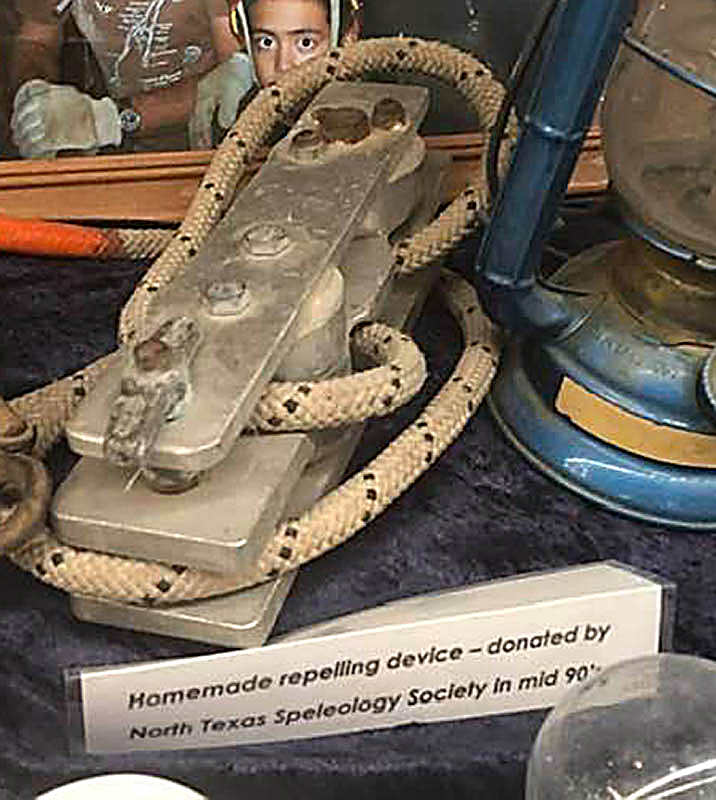Technical Details
 I made my Storrick – NTSS Double Spool in 2021, basing it on one that is on display at the Caverns of Sonora in Texas. Special thanks to Bill Stele for spotting it and to Bill Sawyer at the Caverns for sending me several photographs, allowing me to get the dimensions needed to make a copy.
I made my Storrick – NTSS Double Spool in 2021, basing it on one that is on display at the Caverns of Sonora in Texas. Special thanks to Bill Stele for spotting it and to Bill Sawyer at the Caverns for sending me several photographs, allowing me to get the dimensions needed to make a copy.
My Double Spool is 162 mm. tall, 82 mm. wide, 34 mm. thick, and weighs 594 g.
The Double Spool consists of two bollard pairs sandwiched between three aluminum plates. I made the bollards and plates out of 6061-T6 aluminum alloy. The front plate is 1" x 1/4" (25 x 6 mm.) and the other two are 1-1/2" x 5/16" (38 x 8 mm.). The central plate has two curved and angled cutouts that allow the rope path to pass from the rear channel to the front channel and back. The easiest way to make these cuts is to mount the plate in a fixture, hold this in a dividing head, tilt the head, and mill the channel.
Although not visible in the finished device, the bollards have 5/16" (8 mm.) projections on the central end. The front bollards have 1/2" (13 mm.) projections that nest within holes in the ends of 3/4" (19 mm.) projections on the rear bollards. These, in turn, fit into reamed holes in the central plate.
I held the bollards in place with two 1/4"-20 UNC stainless steel bolts each, with washers and lock nuts as seen in the photos. A 3/8" x 1.5" (9 x 38 mm.) quick-release pin provides a tie-in point that can open for rigging, and a short chain keeper helps prevent its loss.
I tried to copy the visible elements original rather than make improvements, but I did use the two-bolt arrangement on the original’s lower bollards on the top pair as well. If I were to do this again, I would probably use a single central bolt for each bollard pair, and add hidden stainless steel anti-rotation pins. The original did not have a QR pin keeper, so I added one.
My initial impression was that the rope path is bonkers, but it actually makes a lot of sense. The double spool provides more friction than a standard bobbin, and does so in a compact device. As with any device, performance depends on the rope in use. I found that it required some hand feeding when used with stiff PMI Pit Rope (and at 198 lb (90 kg) I'm at the upper limit of healthy caver weight), and was a bit fast for my taste but still fully controllable on 9 mm. BlueWater II.
Despite having tested the double spool on PMI Pit Rope, it is not a good choice for that rope. The problem is the separation between the bollard pairs - Pit Rope is too stiff to allow inserting a bight between the rollers, and requires having the rope end available for rigging. This rules out use on my favorite rope, but is not a problem with limp-noodle ropes. Increasing the spacing between the bollard pairs would solve the problem, but result in a larger, heavier descender.
My Double Spool is quite heavy for its size. One could certainly use thinner aluminum for the plates - perhaps 3/16" or 1/4" (5-6 mm.) for the central one and 1/8" to 3/16" (3-5 mm.) for the others.
When using the double spool, pay attention and clip into the channel that the standing line exits. Clipping into the other side is not dangerous, but does cause the Double Spool to run a bit crooked.



